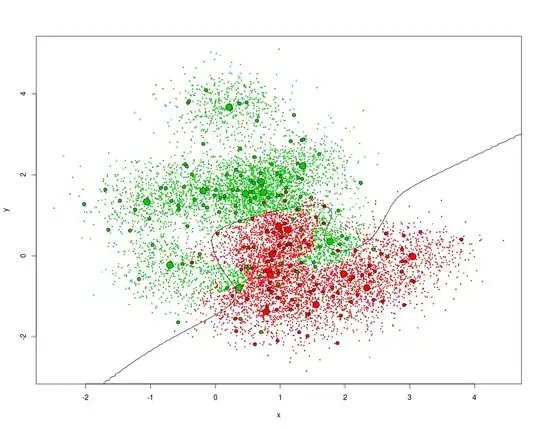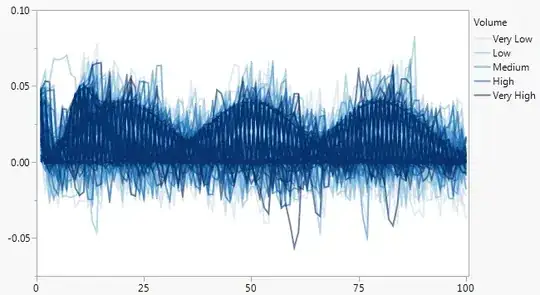The final goal is to predict the effect of intervention(A) on outcome(Y) in the presence of some confounders (x). Before running the model to evaluate the effect of A on Y, I am doing some Exploratory Data Analysis (EDA) using linear regression at univariate level , Y~A+$x_1$, Y~A+$x_2$, Y~A+$x_3$.....Y~A+$x_p$ so on. I am not finding any signal, $A$ has no effect on $Y$ at univariate level. Does it makes sense to run the final model with all the variables ? Is there a mathematical explanation why adding more variables (X) might make matter worse when there is no signal at univariate level ?
- 332
- 1
- 7
- 375
- 2
- 12
-
1Not to discourage you, but [it is possible for a problem to be hopeless](https://stats.stackexchange.com/questions/222179/how-to-know-that-your-machine-learning-problem-is-hopeless). (I, however, consider it interesting to lack signal in a data set. If you’re trying to make important predictions based on those data, it is valuable to know that you can’t do much.) – Dave Dec 02 '21 at 01:47
-
@Dave thanks for the suggestion. – Science11 Dec 02 '21 at 01:55
-
2Doing multiple regressions like this will not adjust for confounding of multiple x's at once. For example, if $x_1$ and $x_2$ jointly confound the effect of $A$ then it could be the case that two univariable linear regressions adjusting for $x_1$ and $x_2$ separately fail to elucidate the effect of $A. Its always best to pre-specify the model you wish to examine and then fit that model. – Demetri Pananos Dec 02 '21 at 01:59
-
@DemetriPananos are you referring to interaction ? – Science11 Dec 02 '21 at 02:40
-
@Science11 No. Are you familiar with confounding? – Demetri Pananos Dec 02 '21 at 02:51
1 Answers
Multidimensional patterns
You can have patterns in the data that are not clearly visible when you look at single variables.
This is possible in linear regression like the example below.
In this figure there is a clear difference between the two types of wines. But if you'd look at only a single variable then the difference is not so clear.
And there are even more possibilities when you have non-linear patterns like the next example
 In this figure you see a nearest neighbours classification at work. The boundary is not a simple linear combination and many different patterns become possible.
In this figure you see a nearest neighbours classification at work. The boundary is not a simple linear combination and many different patterns become possible.
Why adding confounders
Confounding variables are variables that both influence the treatment variable and the outcome variable.
This happens for instance in epidemiological research. For example, say you observe beer consumption and the occurrence of breast cancer, then these would have a negative correlation as being a woman is an important confounder that positively influences the probability of breast cancer but negatively influences the consumption of beer.
Controlling for non-confounding variables
In your question, you speak about an 'intervention' which sounds like a controlled experiment in which the other variables are not confounding variables as the intervention is made randomly and with no causal relation with the other variables.
The effect of controlling for other variables is to reduce the variation in the outcome that may be potentially caused by other variables and may be correlating with those other variables.
In this case, it might be that you do not observe a significant effect when you control for only a single variable and you might need to have more variables included.
For a single variable, you may have the situation below
The histograms on the right show that there is little difference in the outcome for the two treatment groups.
However, the scatter plot on the left shows that there is a difference. It is just that age has a much larger influence that makes the small effect of the treatment, not significant if the effect of the age is not taken into account (because the age becomes a large source of noise when it is not taken into account).
For multiple variables, you can imagine a similar situation but just with more variables. If the variables have a strong influence or at least are correlating a lot with the variation in the outcome, then you may need to add it as a control variable and just controlling one by one is not enough. (alternatively, if control variables have a lot of influence then it might be better to 'control' it and make sure that the experiment has little variation in this parameter)
- 43,080
- 1
- 72
- 161
-
Regarding: `In your question, you speak about an 'intervention' which sounds like a controlled experiment` , I am dealing with observational data, my dataset is not from RCT, – Science11 Dec 03 '21 at 08:46

